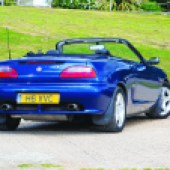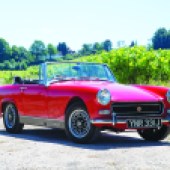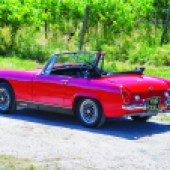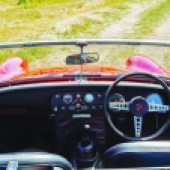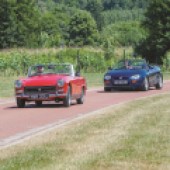These may be two very different MGs but they both represent the marque’s success in creating accessible sports cars from mainstream saloon car running gear. In MG Midget v MGF, which gets the vote today?
Firstly, I’ll admit that comparing the mid-engined MG from the ’90s complete with its twin-cam fuel injected engine and fluid suspension with the 1950s-derived Midget with its leaf springs and lever arm dampers is perhaps an unfair comparison.
But hear me out: both the Midget and the MGF played an important part in the history of MG the brand and both appealed to similar buyers in their own era, while their development also had some remarkable parallels. Derived from the Austin-Healey Sprite, the Midget was developed by a tiny team (by motor industry standards) at the Healey Motor Company, while the MGF was similarly developed on a shoestring budget and both cars used running gear plucked from the smallest saloon car in the company’s range to good effect – the A30/35 in the case of the original Sprite and the Metro in the case of the MGF.
Both were also marketed as affordable sports cars and would go on to lead remarkably long lives – the Midget lasting until 1979 and the MGF enduring into a new century under Chinese control.
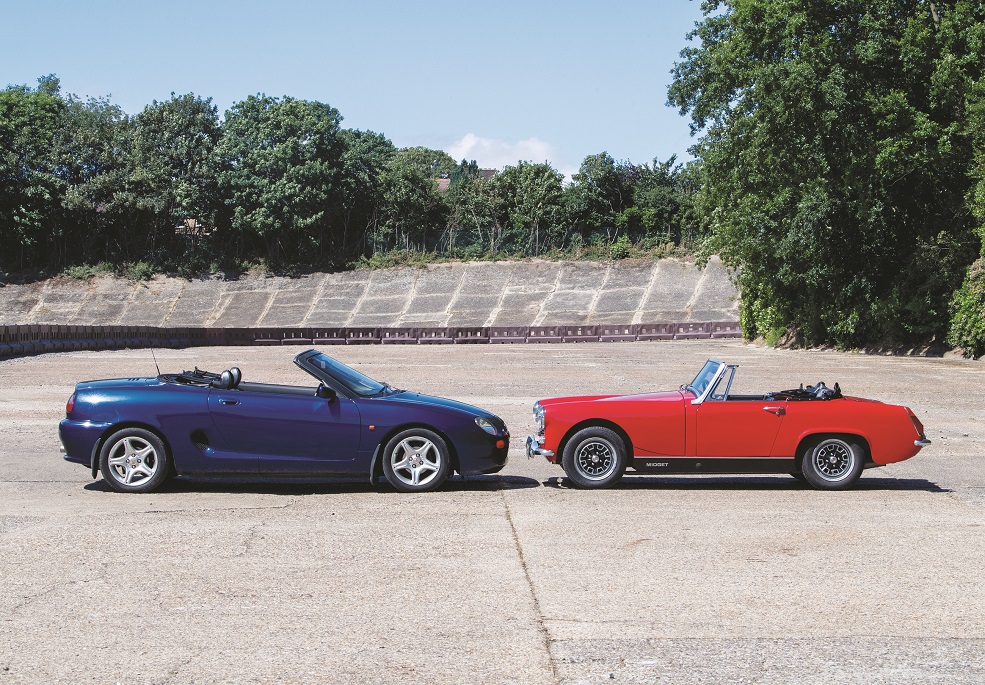
Today the Midget offers just as much fun as it did when it was first introduced and is also one of the most affordable entries into the chrome-trimmed MG era. The MGF meanwhile is currently one of the modern classic bargains of the moment, with perfectly viable cars available for just a few hundred pounds – in other words, it’s where the Midget itself was not so very long ago.
Which makes the better choice as a classic today? We took a 1971 Midget and a 1997 MGF on a road trip to find out.
Driving the MG Midget
You don’t hear the phrase so much these days, but ‘Spridget’ was the word used to describe any of the Austin-Healey and MG versions of the car which began life as the Sprite before being badge-engineered into the Midget. The original Frogeye was distinguished by its one-piece flip front but once the car had evolved into its Mk2 version from which the Midget was created, the two were identical save badging and minor trim details.
A reminder of how much the motor industry has changed since the 1950s is that although it was destined to become a major product of the mighty BMC, the original Sprite was developed by a tiny team at the Healey Motor Company. Donald Healey had formed a joint venture in 1952 with BMC boss Donald Stokes with the intention of producing a range of sports cars to be badged as Austin-Healey, of which the first had been the so-called ‘Big Healey’ more often seen as the Healey 3000. When this proved to be a success, thoughts turned to a similar collaboration to produce a cheaper sports car which could once again use Austin running gear.

Simplicity was to be the key with the new car and at one point even using the same front and rear wings was considered to save costs. The car’s equipment was pared right back without even external door handles or boot lid in order to get the cost down to the point where it would tempt young blades to trade up from motorcycles – indeed, one of Healey’s briefs to the designers was that it could be ‘the type of thing a chap could keep in his bike shed.’
The body itself was intriguing and in many ways an exotic contrast to the basic nature of the rest of it: often considered to be the world’s first monocoque sports car, it took cues from the Jaguar D-Type to feed the rear suspension stresses into the bodywork and avoid the need for a separate chassis. At the front end, two protruding ‘chassis’ legs are more traditional and mean that technically the Spridget isn’t a true monocoque but a hybrid of the two approaches.
The mechanical make-up of the car was more conventional and largely plucked from the extensive BMC parts bins. The front wishbones and springs were Austin A35 parts, allied to lever-arm dampers, while the steering rack was the kind found in the Morris Minor. The engine was the familiar A-Series, initially in 948cc flavour and paired with a Minor/A35 style gearbox.
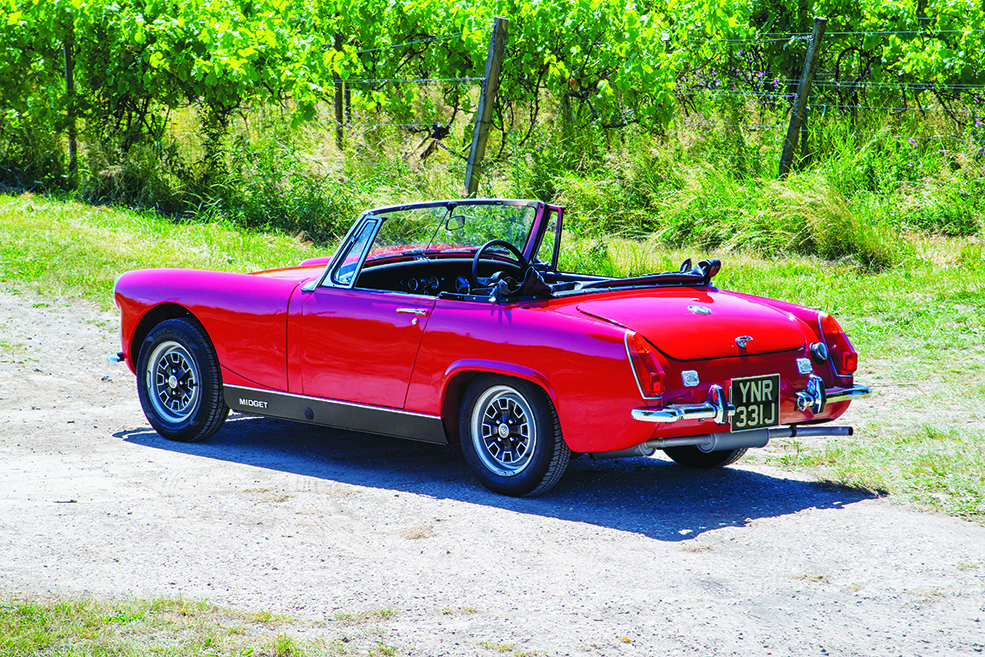
The car went into production at MG’s Abingdon plant and when the original was restyled to be given a more conventional appearance, it made sense to market it as an MG model too. The T-Series Midgets had been discontinued in 1955, meaning that the MG marque needed a lower-cost model to sit below the MGA.
The redesign was largely cosmetic and was aimed at making the car more practical. A conventional front end was added with fixed wings and opening bonnet, while the rear end gained an opening bootlid, with the body structure suitably reinforced to cope with the resulting stresses.
Launched in 1961, this represented the first generation of the MG Midget. It was powered by the same A-Series engine fitted to the Sprite and both cars were devoid of outer door handles and, like the Frogeye, had removable Perspex side screens in place of wind up windows.
The Midget was given a power boost in October 1962 when the capacity of its 948cc engine was raised to 1098cc, a move that boosted output to 56hp at 5500rpm and made MG’s little sports car more competitive when compared with Triumph’s new Spitfire. Other improvements included fitting front discs instead of twin shoe drums and optional knock-off wire wheels became available for the first time.

In 1964 the MkII Midget made an appearance, the biggest improvement being to the rear suspension that now featured semi-elliptic springs, a move that reduced the car’s tendency to understeer. MkII Midgets received a new, curved windscreen, opening quarter lights and wind up windows. It was all change again in 1966 when the Midget’s A-Series engine was enlarged once more to 1275cc and the addition of a fully folding hood rather than the previous removable item was the only major change to the car’s metal work.
Further styling changes were made when the MkIII came on the scene in 1970, the year the almost indentical Austin-Healey Sprite ceased production. In 1972 the Midget underwent its most major revamp to date when rounded rear wheel arches replaced the previous squared off items. Although smart Rostyle wheels now graced the revised Midget’s wheel arches, ever-stricter emissions and crash regulations in the USA were set to radically change the overall look of the next generation of this popular car.
In 1974, the final MkIV version of the Midget was launched featuring pair of bulky ‘rubber’ bumpers in place of the previous chrome items. The ride height was raised and under the bonnet the A-Series engine had been replaced by the 1493cc unit that also powered the Midget’s arch-rival, the Spitfire. Marketed as the 1500, this was the fastest Midget ever, as its 65bhp Triumph-sourced power plant made this game little MG a genuine 100mph sports car. Despite the Midget continuing to sell well, it was axed from the MG line up in 1979 and sadly slipped down the ranks and became the ‘forgotten’ MG.
The car we have here is a 1971 example, which means it sports the chrome detailing of the pre-1500 models but regardless of the era, all Midgets offer a very similar driving experience.
I’ve often found that after time away from these cars the diminutive doors always serve to remind you just how compact the Midget is. For a six-footer, getting comfortable behind the wheel involves suitable footwear – chunky boots are definitely out – and some wriggling, but once you’re in, it’s a surprisingly comfortable place to be. It’s certainly a less intimidating prospect than a Westfield or similar and feels very much more like a proper car, despite the seating position putting you at eye level with Range Rover door handles.

Finding the ignition lock on the later Midgets is always a bit of a fumble, but on a ’71 example like this, it’s easily found in the centre of the dash and of course a well-sorted A-Series generally bursts to life without much fuss.
In 1275cc form, a Midget always feels that much more enthusiastic than the later 1500-engined car which although ultimately more powerful are less happy to rev and feel somehow more pedestrian.
There’s a brisk trade in modifying Midgets, with some even fitting the K-Series engine and although it does create a surprisingly rapid result, the Midget is one of those cars best enjoyed in standard or near-standard form. The original Frogeye gives the sensation of high speed at a mere 30mph and the later Midgets like this offer a similar experience, even if the 1275 motor does give them a decent turn of speed.
It all feels like a proper sports car too, with the gearlever set high on the centre tunnel and clicking through the gate with a nicely short travel and precision, while the rack-and-pinion steering borrowed from the Minor gives it a lovely precise feel.
The Midget is one of those cars which begs to be driven with enthusiasm and it can give a remarkably credible account of itself too, although the leaf-sprung rear with its old-fashioned dampers does make it wallow and bounce when it’s really being pushed hard. There are even those who will claim that the Midget is a better handler than the larger MGB and there’s some justification to that claim.
As for the practical side of ownership, well the A-Series engine is a familiar prospect, part supply for the cars is second to none and the Midget even offers boot space on a par with the original MX-5.
How though does it compare to the much more complex car which represented MG for a new generation?
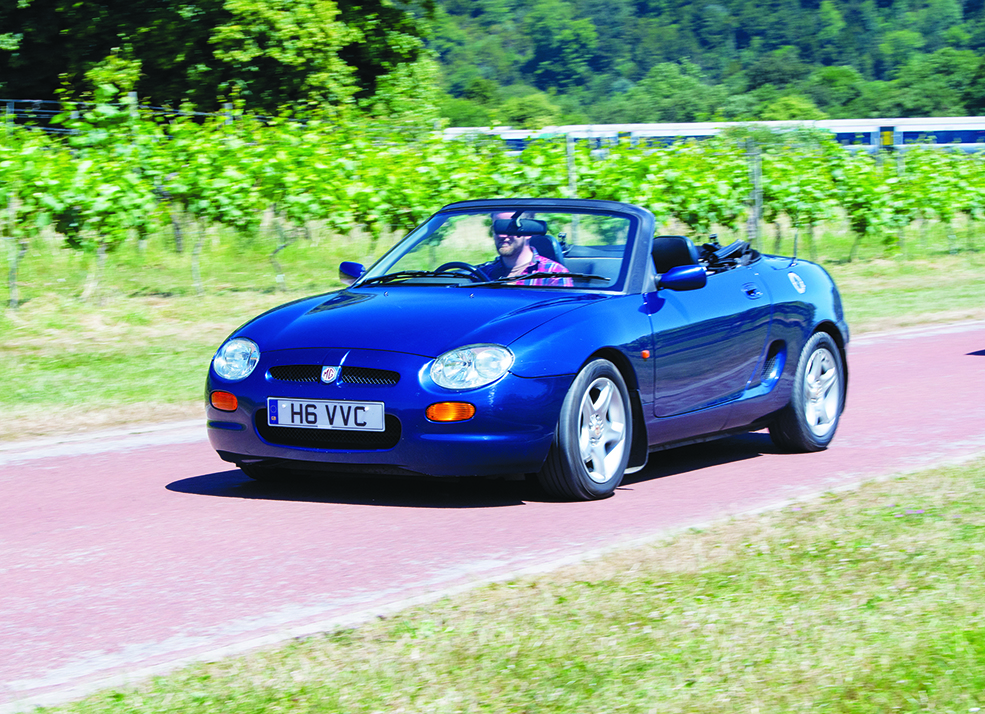
Driving the MGF
A colleague who spent some time with our own MGF project car recently Tweeted a comment to the effect that it was a great sports car… for 1983. The comment was born from the slightly low-rent interior ambience with its parts-bin details from older Rover Group models but in reality a car with the MGF’s spec would have been properly exotic just a few years after Midget production ceased: multi-point fuel injection, twin overhead camshafts, variable valve timing… and Hydragas suspension giving it the supple ride of a car twice its size. Except of course that last feature would already have been old hat even when the Midget was still rolling out of Abingdon.
Like the Midget, the MGF was born from a need to fill a gap in the MG line-up: with the traditional MGB and Midget had long since gone, the octagon badge had been successfully applied to a new generation of front-driven cars but with the Metro, Maestro and Montego out of production the MG marque had temporarily disappeared.
Except that when Mazda’s MX-5 reminded the world of the appeal of a back-to-basics roadster, Rover Group management suddenly remembered the octagonal badge and tentative proposals for a reborn MG roadster they’d left festering on the shelf. The RV8 was promptly developed via a quick update of the MGB and in the meantime, what would become the MGF was taking shape.
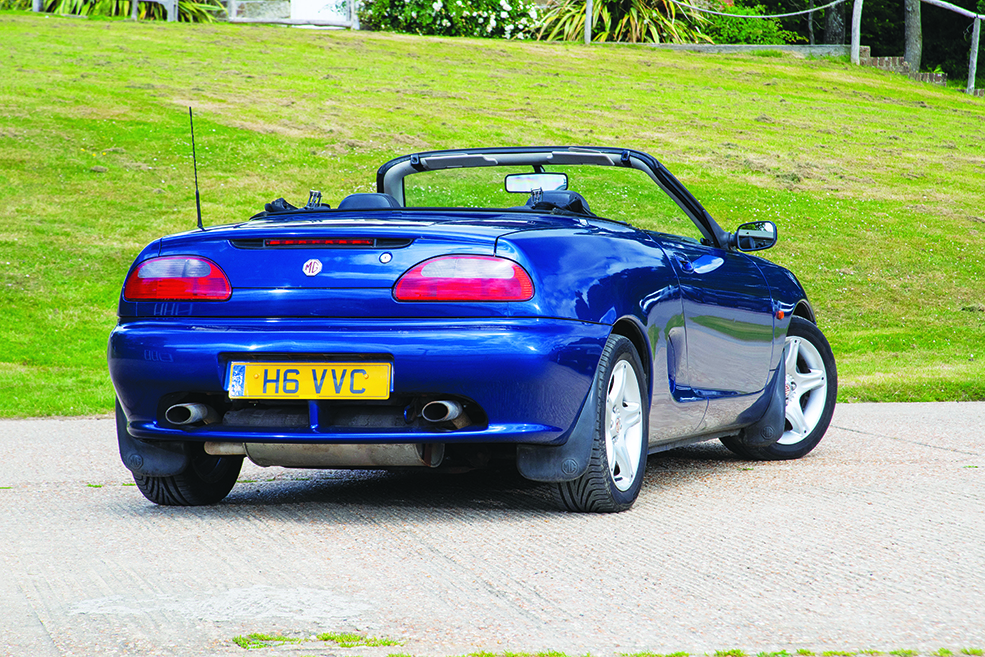
Various directions were explored, including a front-engined V8, a Maestro-based front-driver and what eventually made production: a mid-engined car using essentially two Metro subframes, one with an engine but no steering and one with steering but no engine.
The result was very much more than the sum of its parts and even the sale of Rover to BMW during its development didn’t prevent it making production – its case helped by its performance against the Z3 in the hands of BMW’s own test drivers at the Nürburgring.
The MGF was launched in September 1995 with the 1786cc, 125 bhp K-Series, with the VVC version arriving in 1996 with a clever variable valve timing system producing 143bhp. With the car weighing just over a tonne, this provided spritely performance and the free-revving K-Series was ideally suited to a sports car.
As befits the Metro connection, the MGF is a pretty compact car, but still noticeably larger than the Midget – especially in terms of its width.
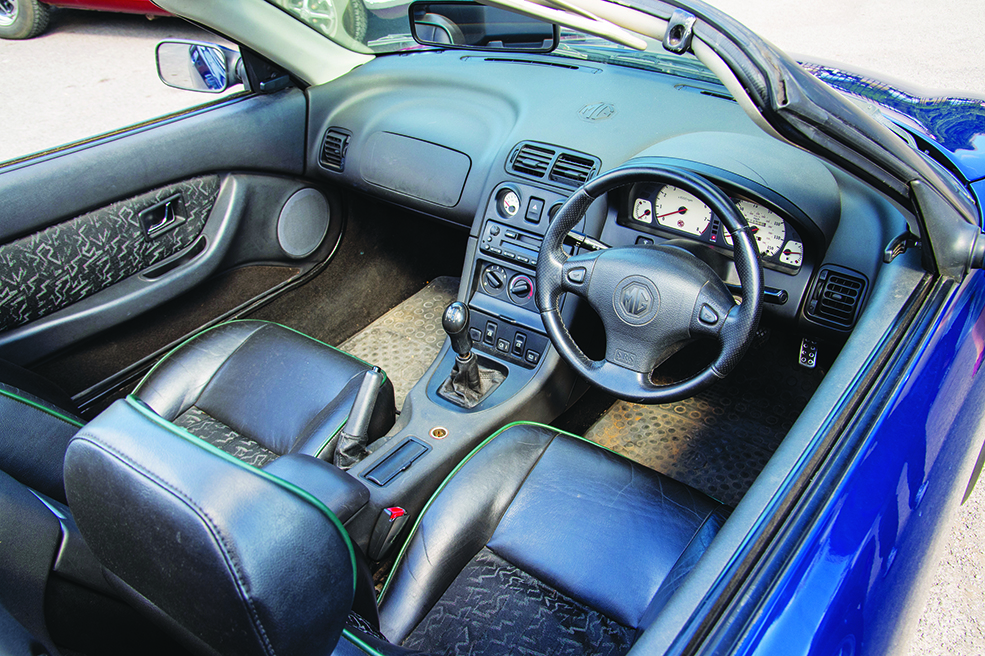
One MGF trait which won it plenty of sales over cars like the MX-5 was its familiarity to hatchback drivers: the driving position is more saloon-like, with a higher seat, longer gearlever and without a big central tunnel. This was an inevitable result of using hatchback running gear but the result was less intimidating to drivers who had never experienced a traditional saloon car. Yes, it feels more Rover 25 and less special than the Midget, but there were plenty who loved it for its fuss-free nature.
Modern injection means the MGF starts and runs cleanly from cold whatever the weather and in that respect it’s a world away from the Midget’s carburetted A-Series and manual choke. On first acquaintance, the MGF feels pleasingly brisk rather than rapid, but the VVC is a real surprise. You need to drive it hard to get the best from it, but once you do, the car comes alive and the shift to the high-power valve phasing at higher revs is far more progressive than the sudden step of Honda’s VTEC.
In a straight line, a hard-driven MGF VVC will surprise drivers of many cars which would look down their noses at the old MG: Golf GTIs are fair game if you’re committed and even modern turbodiesels need to be on boost to get one over the little MG.
Its mid-engined layout also affords it excellent traction off the line and when it comes to handling, the car’s limits are generally higher than the driver’s. Unlike the similarly mid-engined MR2, the MGF will tend to understeer initially and feels relatively benign at the limit. On quality tyres, there’s little which can touch a well-driven MGF VVC across country. And all this is achieved with a serene comfort thanks to the Hydragas which allows enough compliance to keep the rubber firmly in touch with the ground and also leave occupants feeling unflustered. It also makes the MGF a surprisingly decent motorway cruiser, with only the fluttering of the spindly Metro wiper arms to limit progress in the wet.
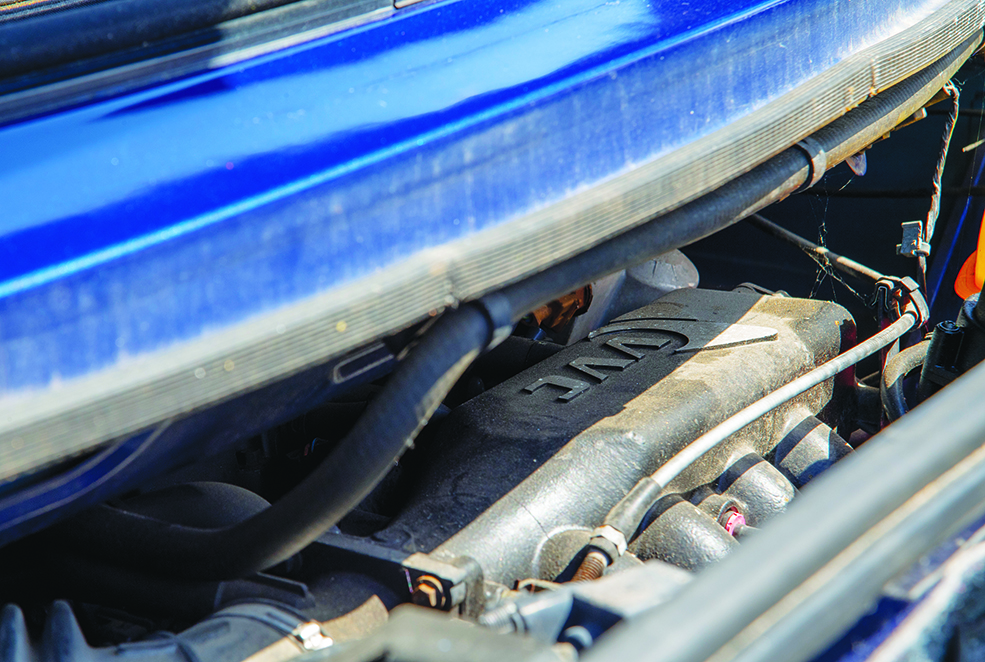
Downsides? Well the boot space is on a par with Midget or MX-5 but instead of being shallow and wide is deep and narrow – and slightly warm thanks to the engine in front of it and the exhaust underneath. Yes, there’s a small storage compartment under the front lid but that’s largely occupied by a full-size spare, the electric power steering and the screenwash bottle.
As for the ownership proposition, well there’s an unwritten rule in car journalism that you can’t mention the MGF without mentioning K-Series head gaskets, but in reality the problem is very much overblown. Yes, the engine did gain a reputation for head gasket problems but any still on the road today will have by now been fitted with the uprated part which it’s generally agreed solves the problem. A well-maintained MGF with leak-free cooling system will generally be trouble-free and parts support is the equal of the Midget thanks to the aftermarket. In contrast to the MX-5, the MGF doesn’t tend to rot alarmingly and driven sensibly even the VVC can provide 40mpg. Oh and the best thing about the F? You can buy a decent one for as little as £900. It’s been a long time since you’ve been able to say that about even the rubber-bumpered Midget.
Verdict
I grew up with friends running Midgets back when they were affordable for 19-year olds to run and I gained an appreciation for their giant-killing ability and user-friendly nature. More recently though I’ve also spent a year and thousands of miles in our own MGF VVC project and grown to appreciate it just as much.
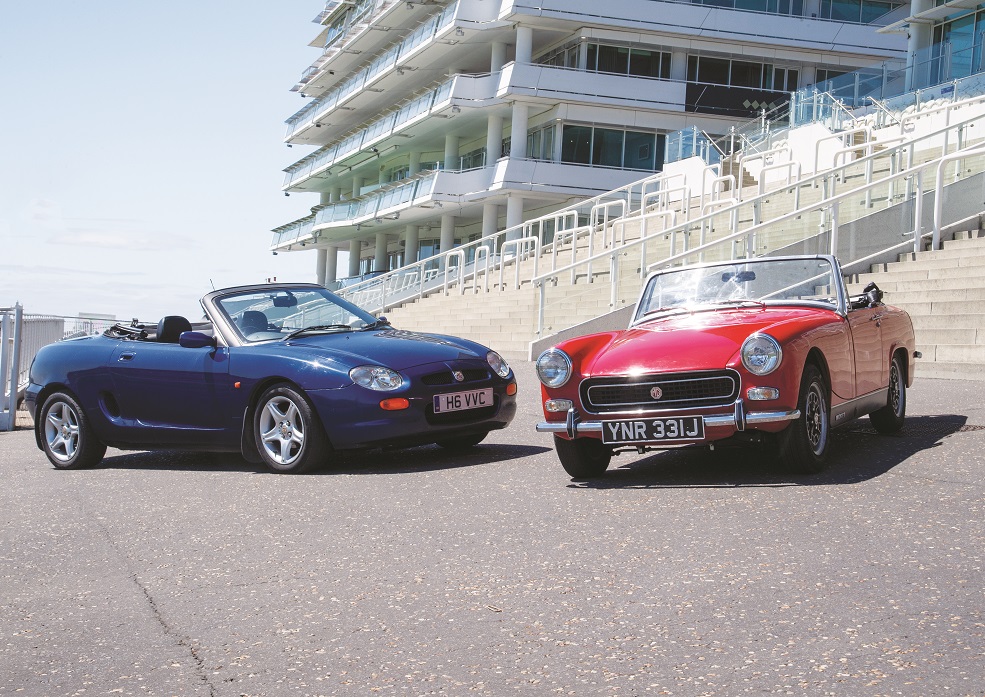
If it’s the traditional classic you’re after than the Midget still remains something of a hidden gem amongst the British classics, so often overshadowed by its bigger brother. But if you’re a fan of the underdog then grab yourself an honest MGF VVC, spend a bit of time and effort sorting out the cosmetics and enjoy it while you wait for values to rise: they surely can’t fall any further.



